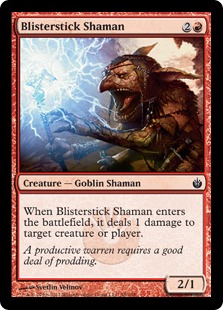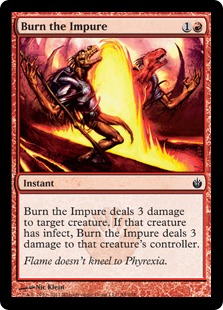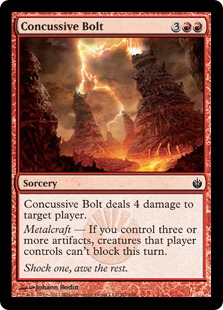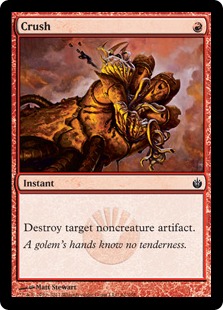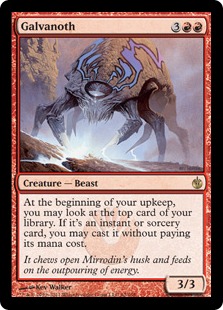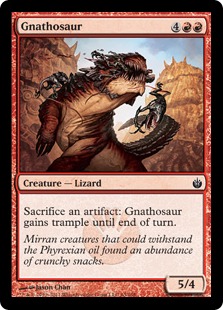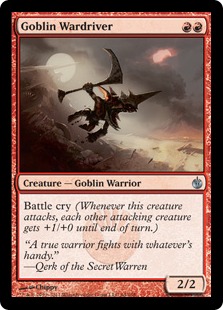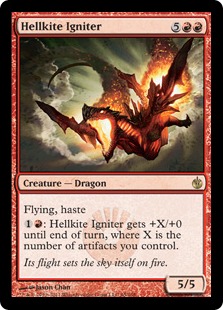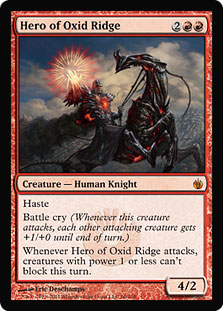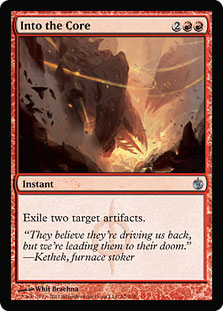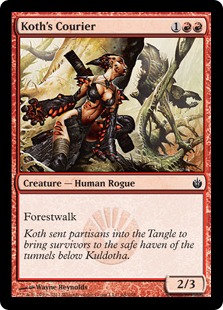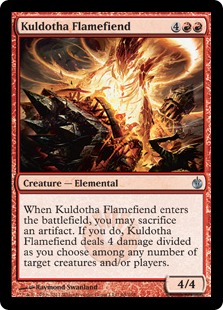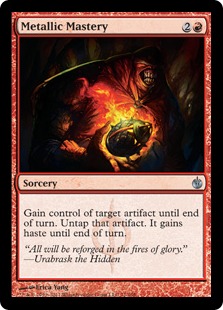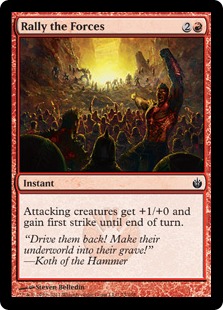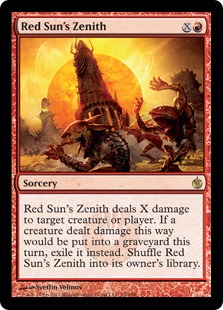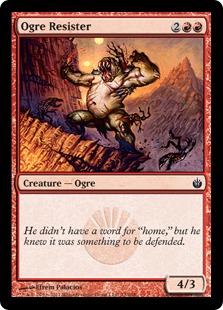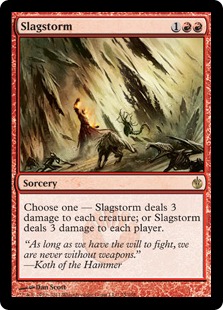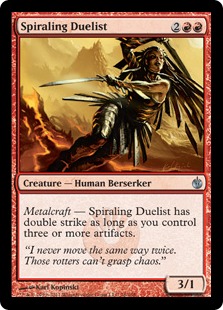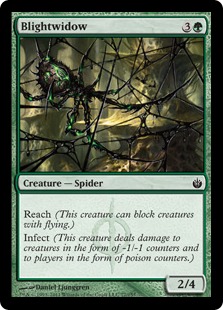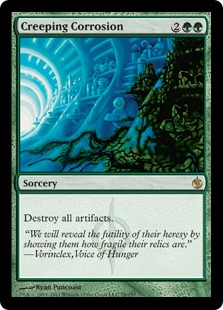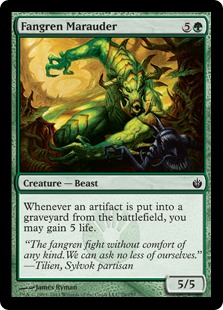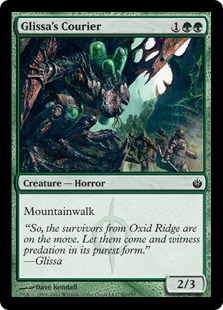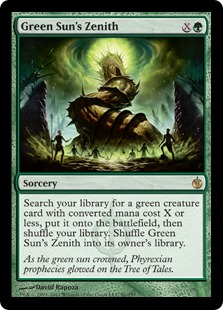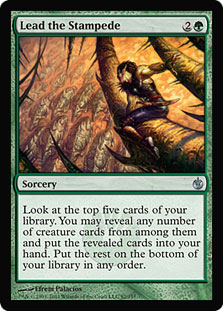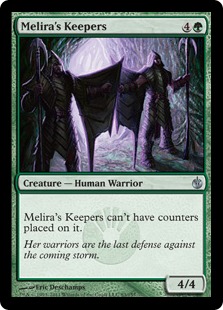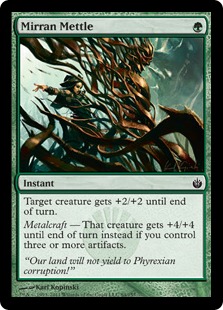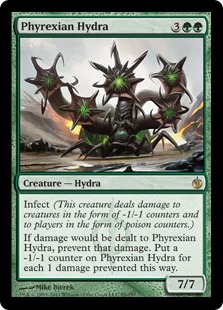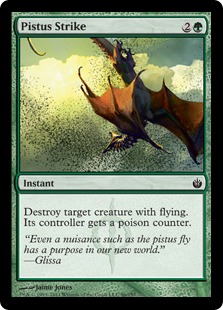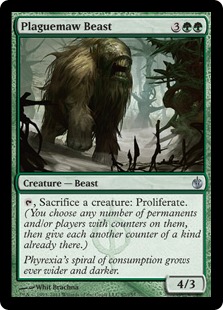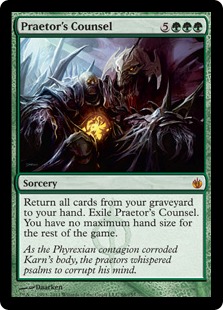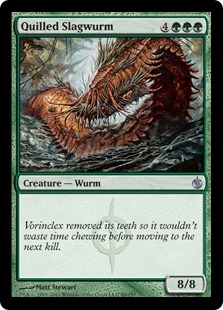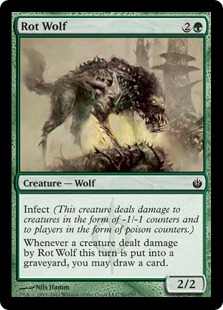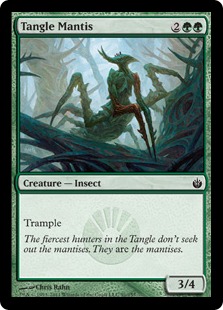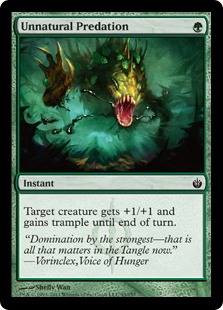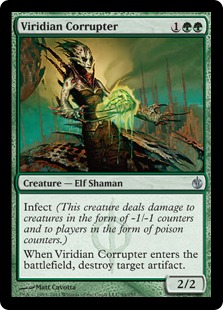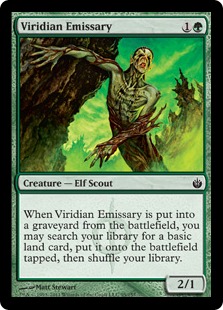Welcome to the conclusion of my Mirrodin Besieged Set Review. You can find
Black, Gold, and Land here
, Artifacts both here
and here, and Blue and White here
. Today, we finish up by breaking down the red cards and green cards.
Red
Sparkmage Apprentice never saw any play as basically the same card but a mana cheaper and only a 1/1. The second point of power isn’t worth the mana
when this type of effect is best against Lotus Cobra and Birds. The one saving grace of Blisterstick Shaman is that he at least had the decency to be
born to Goblin parents. Unfortunately, he picked the wrong spot in the curve to make his mark on the world. The Goblin tribe is notoriously deep at
three, so you would have to really want this as some strange kill card for some Goblin combo deck. Ghitu Slinger sees occasional play for a
similar function, so it’s conceivable that some deck with Goblin Matrons might be able to set up a loop with this.
While not likely to show up in Constructed, this is a pretty cool one for Limited. Scars Draft is a format with an unnaturally high number of
one-toughness creatures (in order to make infect more relevant). On turn 3, hitting a Myr or infect creature or a Smith they played on two seems
reasonable. He isn’t as good as Instill Infection, in my opinion, but there’s definitely room for worse cards than Instill Infection in one’s draft
deck.
Excellent removal, very first pickable. Wait, this isn’t a Limited set review? This is a Constructed set review? Well, in that case, I’m not as big a
fan. Red is not exactly short on spells that deal three damage to a creature. Burn the Impure can’t even hit players, meaning that it aspires to just
be a really bad Flame Slash, against except infect. Even in an infect-heavy metagame, we’re still just building a Searing Blaze. We can do much better.
Burn the Impure’s day in the sun will come in Block where there might just be so little competition and so much infect that it has a role. Watch for it
when the Pro Tour returns to Japan!
Lava Axe is nowhere near Constructed playable, and it would have to deal at least seven damage just to get into the conversation. At only four
damage, Concussive Bolt means you have to be pretty sure you cannot only acquire metalcraft, but that making your creatures unblockable is worth more
than three additional damage. That doesn’t even take into consideration how much work you’re doing and how often it’s going to fail. Seriously, against
half of your opponents, they aren’t blocking anyway.
As for Limited, the card is sweet. It puts looming doom over the heads of all your opponents, and in Limited, it’s trivial to have your team be worth
three or more damage (and I’ve actually played straight-up Lava Axe numerous times).
The most interesting element of Crush is its ability to kill living weapon creatures, if you ask me. The one-mana savings is important, to be sure, but
as a “bad” Oxidize, it’s not particularly impressive. We have much better options in powered formats to be excited about this, though Overload has seen
play, so it’s a possibility. As for Standard, too many of the decks that would use equipment are the same decks that would play Memnites, Ornithopters,
and Signal Pests. If Crush is to see any play in Block (or anywhere else, for that matter), you’re going to care more about the mana savings (tempo)
than the ability to hit artifact creatures (versatility) as compared to Shatter. That seems unlikely but certainly possible.
Obviously, this ability is tailor-made for casual formats, such as Commander, Cube, and Type 4. When it comes to actual sanctioned play, this screams
too much work for too little payoff on too fragile a body. If it were going to work, you’d probably need a super powerful instant or sorcery, such as
Cruel Ultimatum, to make sure you were actually getting paid for going to the trouble. You’d need some way to put it on top of your library. It’s
possible that Jace would be enough, but some sort of Mystical Tutor action would be more desirable. Unfortunately, even if you do all this, you still
need a five-mana 3/3 to live a turn, and even then, how much have you really saved compared to just casting whatever spell you “cheated?” I’m not
saying it’s impossible to abuse this guy; just that one has his work cut out for him making it worth doing (and I predict it won’t happen).
As for Limited, you’re generally not going to have a lot of “hits,” but a 3/3 for five isn’t the end of the world. As such, I can imagine digging for
Concussive Bolts, Galvanic Blasts, Arc Trails, and so on, to be “good enough.” You probably don’t want this guy anywhere remotely early, but you do
pick him up in the first pack, so you’re slightly more likely to draft a deck where he’s actually playable.
You know the drill at this point. I wouldn’t play this for four, let alone six, so holler back when the Lizard Lackey gets printed. Yeah, he lets you
sacrifice artifacts for free… after the initial investment of Inferno Titan’s casting cost. As for Limited, my favorite Gnathosaur synergy thus far
is with Ichor Wellspring.
The unassuming Goblin Wardriver is actually a pretty hardcore beatdown machine. Even with all the power-creeping going on, a 2/2 for two is not the
worst starting body for a red creature. Additionally, the battle cry mechanic is quite powerful when well-placed. Goblin Wardriver, for instance, is
often at least worth a 4/2 (if you’re playing the right deck for him). To sweeten the pot even more, he’s a Goblin, which is historically the best
creature type in Magic. Even in current Standard, being a Goblin pays, as Goblin Chieftain makes for a fine turn 3 follow-up to the Wardriver
(especially if your turn 1 was Kuldotha Rebirth or a Goblin Guide).
Goblin Wardriver actually has even more going for it, though. Red is notoriously saturated at the three-spot and light at the two-spot. In fact, the
two-spot is often one of red’s bigger weaknesses, so having such a good rate and on a Goblin that works well with swarms of Goblins no less, Goblin
Wardriver is probably even a consideration for more powered formats.
Legacy Goblins currently only really has Goblin Piledriver at two, so Wardriver might be the perfect fit. The biggest obstacle here is the casting cost
being slightly challenging for a deck that wants to max out on Wastelands and Rishadan Ports. Fortunately, four Aether Vials and four Goblin Lackeys
should let you cheat him with enough time to make up for only sixteen Mountains. He isn’t as good as Goblin Piledriver, but he seems better than any of
the other two-drop possibilities, so I would at least try him.
Goblin Wardriver’s drawback of costing double red isn’t without a price in Standard, as well. Contested War Zone is a perfect fit in most Kuldotha
Rebirth and Goblin swarm strategies that are natural fans of the Wardriver. These sorts of decks don’t exactly have a surplus of land lying around, and
there’s some tension between a creature with no colorless in its cost and a land that only makes colorless. This is far from the end of the world, but
it’s a factor that will leave pilots mana-screwed a non-zero amount of the time or will force them to make deckbuilding choices they might otherwise
not want to.
Hellkite Igniter is almost surely not seeing any play in Constructed, where giant, hasty Dragons are a dime a dozen. For him to be worth it, you would
probably have to have to cheat him onto the battlefield with enough red mana lying around to kill in one hit. This takes six additional mana if you
have five artifacts or four mana if you have eight artifacts. Either way, this is ambitious considering you also need to cheat the Hellkite Igniter
onto the battlefield and fast. As always, our eyes turn to Block where he may prosper from the absence of other giant, hasty Dragons with which to
compete. Hellkite Charger in Zendikar did see Block play but cost six compared to seven, which is a bit poor but doesn’t rule him out. Here, you just
need to want a giant, hasty flier enough to pay above retail.
Obviously a first-pick windmill slam in Limited.
Hero of Oxid Ridge is one of my favorite cards in the set and the type of beatdown card that has been known to corrupt even me. As long as Jace, the
Mind Sculptor is in the format, this temptation only goes so far, but I love how many things this guy does well and how efficiently. To start with, a
four-power haste creature for four is pretty sweet, especially considering that it’s in a color besides green. At least you always know, when playing
against green, the only thing they can do out of nowhere is Vengevine you. A red deck has a plethora of ways to attack you from every angle without
warning.
Attacking Jace, Koth, Tezzeret, Garruk, Gideon, Elspeth, and Venser is just one strength of this. He also makes for an excellent follow-up to a sweeper
but pays big if they don’t have one. Battle cry works excellently with other haste creatures, in my experience, and once you’re talking about Signal
Pest, Goblin Wardriver, Contested War Zone, and Hero of Oxid Ridge, you’re talking a lot of battle cry.
The triggered ability (preventing creatures with power 1 or less from blocking) is actually pretty sweet in the new Standard format. Hero is certainly
costed such that the ability is being tacked on for free, but it generates lots of value, negating Squadron Hawks, Wall of Omens, Overgrown
Battlements, Sea Gate Oracles, Plant tokens, Elspeth tokens, and more. What makes this even more relevant is that these are the exact types of
creatures players count on blocking with in order to survive. When you take away these vital blockers while adding another four-power haster and giving all of your other creatures +1/+0 (making the Hero about the equivalent of a 7/2), you’re talking about a tempo swing of epic
proportions – to the point where you can turn around many seemingly lost games.
Hero of Oxid Ridge’s detractors are quick to point out his vulnerability to Pyroclasm, but with the printing of Slagstorm, how many Pyroclasms are you
expecting? As for Slagstorm, yeah, he dies to that as well, but he would. Being a 4/3 wouldn’t matter much, as he would still get Slagged and Bolted,
so he would have to be a 4/4 to dodge the red sweeper of choice. We obviously live nowhere near that world, but the point remains that the “he dies to
Pyroclasm” defense is crazy talk, at least as far as Standard goes. His dying to Fallout is a much bigger deal in Extended, however.
Costing the same as Koth ensures that he certainly has pretty fierce competition, but Koth is more of a stand-alone card, whereas Hero of Oxid Ridge is
almost certainly the preferred choice in any deck that can actually use him (which is in a lot less decks). He’s also a Knight, which is worth thinking
about if you’re the type to explore Knight Exemplar, though such a Standard deck’s mana seems sketchy at best, at the moment.
Verdict: Will see a ton of play in a very small swath of Standard decks, but in those decks he will crush. Don’t even get me started on Block…
Well, it’s not Rack and Ruin, but it does actually exile the artifacts, giving you added utility against Blightsteel Colossus. Every mana matters, and
a lot, so I’m not seeing Into the Core making it into the core Eternal formats, where Rack and Ruin and Ancient Grudge are generally going to get the
nod. If you were going to prefer this new version, you would have to really want the exile aspect.
As for lower-powered formats, Into the Core is a worthwhile option, though I’m not sure yet if there will be enough decks likely to have two good
targets. The key here is that, not only do you have play against artifact-heavy decks with enough targets that are worth getting, but this has to be
the best way to attack them, as opposed to some other angle of attack. It’s certainly very possible, but the format will really have to move away from
the current trinity of Jace-Primeval Titan-Aggro.
There’s really no telling what Block looks like, but given that this is an artifact block, I’d say Into the Core is an odds on favorite to see play,
albeit likely out of the board.
So that is what Hurloon Minotaur has been missing all this time! It’s kind of interesting to see a red forestwalker (and a green
mountainwalker), but that’s primarily functionally relevant only insofar as Draft is concerned. I actually find the 2/3 body to be a nice fit for Scars
Draft, and forestwalk is certainly handy for racing infect. It will be easy to pick these guys up in the draft late, and they’re random donks that fill
out your forty just fine.
Miles from Constructed but definitely a bit of a bomb in Draft. Sacrificing an artifact is really not that big of a cost, and Pyrotechnics is an
extremely powerful effect, especially in this Block. In general, the attribute that makes a bomb a “bomb” is when you would pick it over the best
removal spell.
Does not compare well to Hero of Oxid Ridge; however he does pose some interesting questions for Limited. I had some success with him, though I did
find it easy to get slightly glutted at five, and his must-attack drawback cost me a bit. There were enough 5/5s showing up that sometimes it would
just get super-awkward for me until I sideboarded in Rally the Forces. This actually turns Kuldotha Ringleader’s drawback into an advantage. If you
just attack with your 4/4 into their 5/5, you’re making a pretty strong statement that “you have the trick.” Kuldotha Ringleader has the excellent
special ability of “must attack” that provides a plausible explanation to your opponent of why you would make such a play, without having anything.
This is an excellent reminder that nothing in Magic (or Life, for that matter) is “purely bad.” Context is everything!
One last note about the Ringleader relates to his creature type. I receive more letters about Giant decks than almost any other non-traditional
archetype. It’s crazy just how many people are currently exploring the Giant tribe in Extended, generally on account of Giants being the only Lorwyn
major tribe to never really have a day in the sun.
These Giant decks take a variety of forms, but the “rewards” for playing the Giant tribe are generally:
I ask each of these players what they are really getting for sticking to the Giant tribe, and most answer along the lines of “I get to play Titans or
Brion Stoutarm.” These are not rewards for being Giants! You could play these no matter what deck you played! The rewards for a linear are cards like
Secluded Glen, Mistbind Clique, Spellstutter Sprite, Scion of Oona, and Peppersmoke. These are super-powerful cards that are not available to other
strategies, even of the same colors.
What do you get for adhering to the Giant tribe?
Ancient Amphitheater – Okay, I’m with you on this one. A dual land is pretty sweet, and Secluded Glen is one of the best cards in a Faeries deck,
a deck that is so successful at least partially on account of having the best mana base. The Amphitheater makes red and white instead of black and
blue, which is a pretty big downgrade, but red and white have a lot less duals available to them, so they appreciate it more. One downside, however, is
that Giants generally don’t come down until later in the game, making the value of having an untapped land slightly diminished. Additionally, my
favorite “Giant-enabler” is the Elvish Hand Servant, a card that costs neither red nor white.
Stinkdrinker Daredevil – Sure, I mean, yeah he is a 1/3 for three, but at least he actually pays halfway decent. Making your sixes cost only four
is a worthy dream, so I can’t hate. He’s quite vulnerable, but let’s just assume this guy is “one of the good ones.”
Blind-Spot Giant – Okay, you lost me. Maybe if you’re on some sort of changeling plan and get paid very well for the Giant creature type, I
guess, but even then, I don’t want to play a 4/3 for 2R with no drawback, let alone a drawback as steep as needing another Giant to attack. Where is
this other Giant coming from? Is it one of these Titans? You’re telling me you’re attacking with a Titan and what you need is a 4/3 that came down
three turns earlier to finally be able to start attacking?
Sunrise Sovereign – Not only does this guy cost the same as Titans, he gives the most unappreciated bonuses ever. What Giant are you actually
hitting people with where this ever matters? Either you hit people with Titans or you don’t. Let’s imagine, however, that you only have a Brion
Stoutarm on the battlefield. The Giant “Lord” gives him +2/+2 and trample the turn you play it. Surely that is good, right? Well it’s, in fact, better
than a sharp stick in the eye (as my father would always say), but how does that compare to just casting a Titan?
I’m not try to stop anyone from building their Giant deck, but if you’re working on it with the intention of taking it to an event with the expressed
purpose of winning, ask yourself what you’re getting for going to all the trouble of playing Giants. Casual formats are the place for themes just for
themes’ sake. If you want a “theme” in competitive Magic, we often call that a “linear,” and you have to make sure you’re getting “paid” (the rewards
you receive specifically for sticking to a linear that cannot be achieved otherwise) enough to be worth the “work” (the sacrifices you have to make in
order to adhere to the linear).
I do not think Kuldotha Ringleader is the missing link for Giant decks.
A very unique effect, so worth keeping in mind for if and when the right situation arises in the metagame where you want this type of effect. By the
nature of artifacts, this seems much less likely than Act of Treason, but the day could come. Generally going to be at its best against artifacts that
enter the battlefield tapped or have sacrifice effects. This way, you’re getting maximum value out of stealing it “until end of turn,” and your
opponent can’t thwart you by using it himself. You could also just be sacrificing it to one of the countless Atog-types, but then you’re hardly making
much of a case for Metallic Mastery over, say Shatter.
Extremely situational, expensive, low-impact combat tricks have not historically performed well in Constructed. This is a fine card for mising in
draft, however, as it’s the type of 23rd card that few play around. Besides, first strike is excellent in this block, and it’s far better to have some
tricks than to play twenty-something dudes.
Obviously just an insane red X-Spell in draft, but when it comes to Constructed, it’s really hard to compare to Comet Storm, a card that doesn’t really
see much play itself. Getting shuffled back is nice, I suppose, but the most interesting feature, here, is the exiling part. This lets Red Sun’s Zenith
help answer Bloodghast and Vengevine, which is always nice. Still, it’s unlikely that this makes waves in Standard or up.
Obviously out of the question for Constructed (in real life), however certainly a healthy-sized body in draft. He is a 4/3 vanilla, so what do you want
me to say?
Slagstorm is easily top 10 in the set and isn’t exactly flying under anyone’s radar. To start with, we have Firespout. Firespout has been a
multi-format staple ever since it was printed and will continue to be. Slagstorm does cost double red and isn’t as versatile when it comes to killing
ground creatures while saving your Vendilion Clique, but Slagstorm has its advantages.
First of all, you don’t need green in order to hit fliers, which does matter. Secondly, the ability to hit players is much appreciated on a Pyroclasm
variant. One of the big drawbacks to Pyroclasm in a Valakut deck is that it’s pretty close to dead in the mirror and against blue decks. Slagstorm can
at least kill a Jace or provide the last three points of damage to burn someone out.
While Slagstorm is assuredly one of the most important cards in Standard and Block, it actually has good chances of making an impact in Extended. It
has to compete with Volcanic Fallout, but if you’re in the market to deal three instead of four, Slagstorm might be your card. It’s especially relevant
that Bloodbraid Elf doesn’t work with Firespout, but works great with Slagstorm (both to actually being able to cast it, as well as being able to just
nug everyone’s face instead of flipping a blank on turn three).
Next, we come to draft, where Slagstorm is without question a windmill first pick. Easy game.
What about Legacy? After all, Firespout sees Legacy play. Here, I suspect that Firespout will continue to get the nod. Hitting the ground is far more
important than the air, so 2R is quite a bit easier for the blue decks to play that want this sort of thing.
As for Vintage, Pyroclasm will probably continue to get the nod over Slagstorm, as most of the creatures you need to be able to kill have two toughness
and cost two.
Even if we could somehow be assured of always having metalcraft, a 3/1 double strike just doesn’t impress at this cost. When it comes to draft, I am
not a big fan here, either. He is harder to cast for a worse body than Blade-Tribe Berserkers when he is not powered up. Then, even when he is powered
up, it’s not like you’re getting paid all that well. One toughness is just such a big drawback, on the plane of Mirrodin. He is certainly playable,
just not exciting.
Green
Holy cow is this guy bonkers at common for draft! It’s so challenging to play against this guy, as he hits hard, is hard to kill, has incredible stats,
and defeats most counter play. What a psycho! In Constructed, you would have to really want that fourth toughness and not have had your fill with just
Phyrexian Vatmother.
Shatterstorm in an artifact block should certainly raise a few eyebrows, but without artifact lands or affinity, this card seems a lot more like Day of
Judgment than a spoiler. Even in Mirrodin-heavy formats, there just isn’t an over-abundance of artifact-centric decks to make this card that
pivotal; however the price is definitely right, and it will see some play. I see Standard gaining a ton from Mirrodin Besieged, but in the end, the
three pillars of Jace/Primeval Titan/Aggro are almost surely going to remain standard. Since few of these decks are “beat” by a Creeping Corrosion, its
Standard play will be somewhat minimal.
Against the various Memnite decks, you have to have a situation where going after their Signal Pests, Memnites, and Ornithopters is worth spending four
mana, out of the sideboard. This is nowhere near as strong of an effect as something like Slagstorm, Day of Judgment, or Black Sun’s Zenith, so I don’t
see wanting this, but it could matter. More likely, if Steel Overseer breaks out, Creeping Corrosion can help keep it in check, particularly in U/G
decks. Another possibility is if some sort of Machine deck or Tezzeret deck (or both) breaks out. Those sorts of decks use tons of incidental artifacts
and are not easily hosed by standard creature sweepers.
Eternal formats don’t really need another Shatterstorm, especially with Seeds of Innocence legal, but this one does make them gain a lot less life.
With the printing of Mox Opal, Affinity is posed to make a rise to power, and this is another fine tool against them.
In Block, this is sure to be a very important card that helps define the format, as it’s easy to use artifacts to try to solve most of your problems,
and Creeping Corrosion creates a price to pay. In draft, this is obviously a truly awesome removal spell that gets first-picked easily.
This guy can be so obnoxious to play against in Limited. I have already had several matches lost by beating my opponent down to single digits; then a
Fangren Marauder hits, and immediately, my opponent is at nearly twenty. Another turn goes by, and he is at thirty plus, with no hope of forward
progress for me ever again.
In Constructed, he costs the same as Primeval Titan, so I suspect you would need to get paid not only for the life-gaining ability (which could be
abused) but for him being a Beast.
Of course Glissa’s Courier is not for Constructed, but it will be interesting to see how it shapes up in draft, where some percentage of green decks
are infect. For the most part, however, this is the archetypal “random donk.”
Easily in the top three cards in the set, if not the best, Green Sun’s Zenith will see lots of play in just about every format. What makes it so good?
No, it’s not just being able to get Primeval Titan or anything like that. It’s that the X you pay is the cost of the creature you’re getting, so you’re
basically getting an Eladamri’s Call for just a single mana. Eladamri’s Call saw lots of play at two, so getting it for one is amazing.
There are a number of additional restrictions, such as sorcery speed, you have to play the guy immediately, and it has to be green, but there are also
some upsides. First of all, it fixes your mana, which is important if your Seas have been Spread, and you’re trying to get a Primeval Titan onto the
battlefield. Second, the fact that it gets shuffled back into your library means that your deck doesn’t actually get thinned out the same way it does
if you tutor a creature out through traditional means. Finally, there are some weird consequences to the way the Green Zenith works, particularly in
Legacy.
In Legacy, you can Green Sun’s Zenith for zero and find a Dryad Arbor. This may not seem like a big deal, but it’s actually beyond awesome because it
lets you cheat the land per turn rule. Additionally, this means that your Green Sun’s Zenith is always at least a Llanowar Elf, a card that
sees a fair bit of Legacy play, as is. Add to this that you can also find Tarmogoyf, Knight of the Reliquary, Qasali Pridemage, Wild Nacatl, Terravore,
and even somewhat ironically, Gaddock Teeg. Alternatively, one can find Nettle Sentinel, Heritage Druid, Wirewood Symbiote, Eternal Witness, or Regal
Force.
When it comes to Standard, Green’s Sun Zenith obviously makes for a much more reliable tutor for your Primeval Titan than Summoning Trap, but he also
opens up new dimensions to a Valakut deck that is already profiting from the printing of Slagstorm. Oracle of Mul Daya is a the exact type of card that
you would love to be able to tutor up but that you can’t afford to play a million copies of. Green Zenith makes finding the Oracle a legit five-mana
threat, rather than getting bottlenecked at six.
Finding Overgrown Battlement is totally awesome, as well. So often, you will play a Battlement on two, then Green Zenith for another Battlement on
three, followed by a tapped land (or you just block). This gives you two blockers and eight mana on turn four. Other fine considerations for the
maindeck or sideboard include Avenger of Zendikar, Acidic Slime, Terastodon, Obstinate Baloth, Thrun, the Last Troll, Joraga Treespeaker (if you want a
“three-drop”), and Birds of Paradise, Viridian Corrupter, Viridian Emissary, and Sylvan Ranger. Being able to play a toolbox gives you so many great
options with a Valakut deck, and now you don’t have to miss 20%+ of the time, like you do with Summoning Trap.
This is not without a cost, however. Summoning Trap’s ability to punish counterspells is an important feature. In today’s world of Duresses,
Inquisitions, Memoricides, and Mind Rots, Summoning Trap isn’t as good as it could be, but if everyone moves away from it, other blue decks can easily
rise up to exploit this vulnerability. Besides, if you’re just casting one spell a turn, you can end up being very vulnerable if this turns into a
Cancel format. For now, however, Green Sun’s Zenith seems significantly better against every non-blue deck, and when you factor in the ability to
sideboard Thrun or just straight-up Summoning Trap, if you want it, this makes Valakut the deck to beat here in Paris this week.
Outside of just Valakut, GSZ will also see play in Standard finding Fauna Shaman and Vengevine. Mono-Green Elf decks would love to have such a
versatile card to help them find their key cards in a timely fashion, as well as pay them for those games where their mana engine works in high gear.
Whether it’s finding an Ezuri and using it or finding some fatty, having this card makes every other card in your deck better. Turn one Llanowar Elves
or Arbor Elf ensures that between four Fauna Shamans and four Green Sun’s Zeniths, you can’t just “hope they don’t draw Fauna Shaman.” GSZ will help
Green Mages find your weakness and multiply it, always giving them exactly what they want most against you.
GSZ will also show up in Extended, though the applications here are likely very similar to the Standard and Legacy ones. In Vintage, the most exciting
use is to find Hermit Druid. If one builds their deck right, tapping Hermit Druid will generally translate into victory, by way of some graveyard combo
like Narcomoebas and a Dread Return. With four Hermit Druids (a card banned in every other format and the only green creature that can make a
compelling argument that it might be better than Tarmogoyf) and four Green Sun’s Zeniths, along with some of the usual restricted cards, you’re a
favorite to stick a Hermit Druid turn one most games. This might as well be the same as sticking a Tinker, as your opponent is now on a one-turn clock.
What would the rest of the deck look like? I’m not sure yet, but it’s certainly a very enticing new option to explore. Perhaps Survival of the Fittest
fits into the equation; after all, four Vengevines is pretty close to lethal without even having to Dread Return, so it wouldn’t take much more to push
it over the edge there. In addition, a single Mox makes turn 1 Survival, turn 2 Hermit Druid an option, and Survival let’s you find Anger to give
Hermit Druid haste.
Creatures (20)
- 4 Hermit Druid
- 1 Carrion Feeder
- 1 Basking Rootwalla
- 1 Anger
- 1 Eternal Witness
- 1 Viridian Shaman
- 1 Gorilla Shaman
- 1 Mesmeric Fiend
- 1 Body Double
- 3 Narcomoeba
- 1 Reveillark
- 3 Vengevine
- 1 Memnite
Lands (15)
Spells (25)

In general, the plan is to Dread Return a Reveillark and set up the Body Double/Carrion Feeder/Eternal Witness combo to get unlimited Regrowths, which
combine with Black Lotus to give you unlimited mana. Normally, you can just kill by attacking with every creature in your deck, save the Anger you
leave in the bin. If you somehow get stuck with no Taiga and have already played a land, you can just Witness back the Green Sun’s Zeniths, cast them
for zero, shuffle them back into your deck, then Witness back your Time Walk and take an extra turn. Ancestral Recalling someone to death is also an
option, though be wary of dying to the Ancestral they eventually draw.
Verdict: Green Sun’s Zenith is awesome in every format!
For a thorough analysis of Lead the Stampede, check out my exclusive preview of the card here.
Overall, I think Green Sun’s Zenith does such a great job of being everything you want that it’s hard to play as many creatures as you would want to
play Lead the Stampede. It’s certainly a very powerful card drawer, but the cost is that you can only play so many noncreature spells in these decks,
and Green Sun’s Zenith is just off the charts. Still, it’s a quite potent card drawer that is looking somewhat like Treasure Hunt in that it will see
some play but faces steep competition for the same effect. Green does appreciate this effect more than blue, so it does have that over Treasure Hunt,
but it remains to be seen if there is a good home to be found.
A Limited card that is a very cool way to help stem the tides of an infect onslaught. Not happening in Constructed unless you’re really
getting paid from some abusive combo that takes advantage of that text in some sort of looping fashion.
Might of Alara and Gaea’s Might saw lots of play when they could give +5/+5. Groundswell is pretty reliably +4/+4 and sees only the most minimal of
play in some infect decks. Mirran Mettle doesn’t really lend itself to a true infect deck, so you’re mostly just playing it “because it’s good.”
Unfortunately, +4/+4 isn’t that good. Still, there could be a Block deck with Carapace Forger and Ezuri’s Brigade that might like this type of
thing, but more likely, they will want their pumps to come from equipment.
This guy certainly hits hard, but he is pretty much just a gigantic donk with no inherent card advantage, impact on the board, or defensive abilities.
Killing in two hits is nice, but at the same cost as Gigantiform and Putrefax, I am not impressed. To want this for Constructed, you would have to find
a way to get paid from his relatively unique combination of stats, damage prevention ability, and infect being on such an unorthodox body.
Pistus Strike only aspires to be a role-player, and for that, perhaps it can see non-zero play, but it’s tough because most infect decks are trying to
kill in a couple big hits from pumps, rather than by inches. As such, the mana cost over Plummet isn’t appealing. Additionally, most of the best infect
cards are black, which opens up Go for the Throat, Doom Blade, and so on. To make it worth it, you have to want to be willing to pay a premium to sneak
in an extra poison counter here and there and for fliers to be commonplace.
A poor rate combined with the same fatal flaws we have discussed so many times before with card advantage, defense, etc. His “unique” ability can be
purchased more cheaply and easily and isn’t even that desirable, when you could just be attacking with your five-drop. Obviously a fine Limited card,
though, letting you further your infect plans, while doing lots of little tricks.
The latest in a long and glorious line of Uber-Win-Mores, Praetor’s Counsel certainly gives you immediate card advantage, though it suffers from not
impacting the board immediately and costing eight. These are the two primary differences between Conflux and Cruel Ultimatum. However, like Conflux,
Praetor’s Counsel is such a dramatic effect that it offers an incredible payoff, if you manage to find a way to cheat it. This is such an overwhelming
source of cards that I have to put it at fringe, as I’m sure that at some point, it will get used in some sick (likely tier 2) combo deck.
Other than that, it’s obviously among the most fun casual cards, especially in Type 4 (a multiplayer cube draft format where players have infinite mana
and can only play one spell per turn).
Unfortunately, Quilled Slagwurm’s “unique” ability is his “Vanilla-ness,” which is currently not highly sought in competitive play. As for Limited,
however, he is another excellent dinosaur option if you’re drafting that sort of deck (a strategy that I kind of think may have gained from Mirrodin
Besieged). Now that there is so much more infect going around, non-infect green cards will be even less fought over.
If you’re in the market for another green three-drop infect creature, he is not the worst, but you would pretty much have to be on mono-green infect to
go this route, and even then, it’s not clear if he is better than Cystbearer and Viridian Corrupter. As for Limited, I like Rot Wolf a lot. He puts a
fast clock on the opponent, and it’s very hard to stop him without ending up down a card.
A fantastic body in Limited, held back only by his negative synergy with infect. Also, another reason I like the dinosaur strategy a bit more now.
Obviously miles from Constructed.
Thrun, the Last Troll is one of the most hyped cards in the set, and in my opinion, probably the most overrated. He is good, sure, probably better than
Abyssal Persecutor, but he is just a role-player, not the format defining monster people imagine. If you can’t think of sixty answers to Thrun, you
aren’t trying hard enough. My personal favorite answer? Not caring. It’s easy to go over the top of him with cards like Titans, and you can just race
him with beatdown. Even if you’re going to “hose” a control deck, they can have tons of ways to mitigate him, not to mention if they can actually
outright beat him (with a Clone, Black Sun’s Zenith, Consuming Vapors, or whatever).
Now that we have heard about how overrated Thrun is, let’s look at the upsides, because there are quite a few. His uncounterability and shroud is much
more relevant in Extended and Legacy, where he makes for an excellent sideboard card. You can force him through Cryptic Commands, Counterbalance, and
Force of Will, plus he dodges Go for the Throat and Swords to Plowshares, while powering through Plumeveils and possibly even Tarmogoyfs, when combined
with Firespout. I particularly like him as a transformational card for decks that do not have creatures maindeck.
Thrun also makes a reasonable sideboard card for Valakut, any random Fauna Shaman deck, and various U/G/x decks, just on account of making sideboarding
awkward for your opponent. When you don’t know if your opponent is on Thruns or how many, it makes it much riskier to sideboard. He’s also a big enough
body that it’s worth considering him maindeck, if you’re on some sort of random midrange deck, though he does fight for some of the same space that
Vengevine takes up.
Verdict: Multi-format role-player that will see lots of play over the years but not the format-defining machine that some fear he will be.
Light-years from Constructed but a cute trick for infect decks in draft. So often you will go to a lot of trouble to enhance an infect creature’s
power. Unnatural Predation gives you a way to convert this into massive “damage.”
If you’re in market for artifact destruction in your G/x infect deck, this one is at an excellent rate. I’m not sure how successful green infect
strategies will be, but he is one of the best elements of them. He is sure to be a powerhouse in Block, assuming green infect exists there, as well. In
Limited, this card is just absurd, being even better than Oxidda Scrapmelter.
Verdict: Constructed role-player
Viridian Emissary is somewhat under the radar, right now, but he is actually at a pretty great rate, if you think you can consistently get him to
fight, or you plan on sacrificing him for profit. He is too clumsy to just slam into decks regardless of context, but if you’re pretty sure he is dying
for profit, he becomes awesome fast. Right now, Standard seems more about ramping and combating Jace, neither of which he does reliably enough, but in
other contexts, I can see him doing some good work. In draft, I have been extremely happy with him, as he seems better than Sakura-Tribe Elder, in many
regards.
Thanks for joining me this week! See you on Monday, when we get back to the business of breaking it!
Patrick Chapin
“The Innovator”


